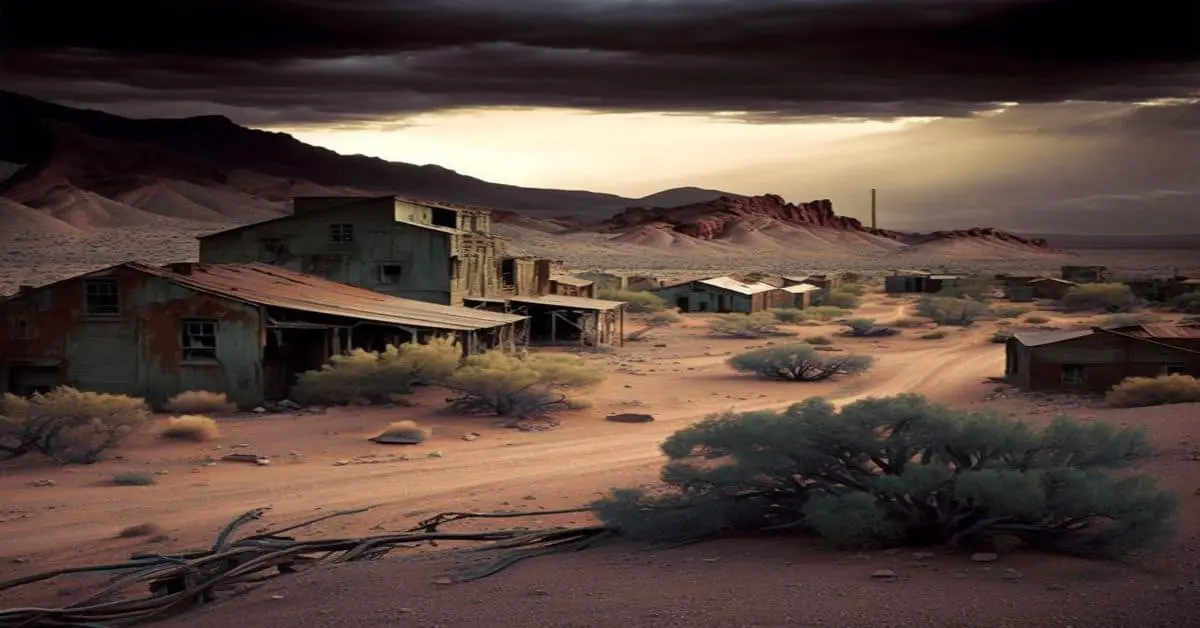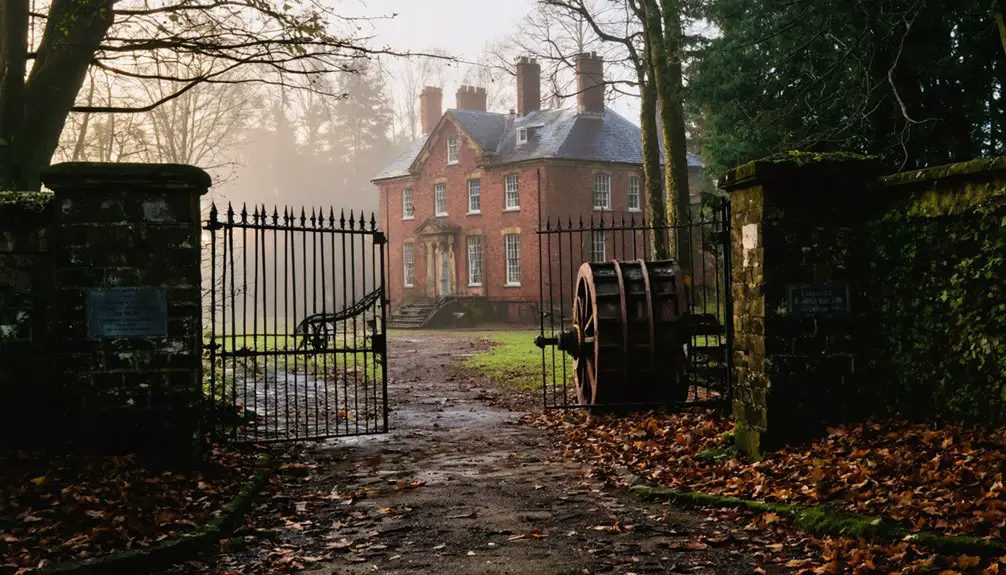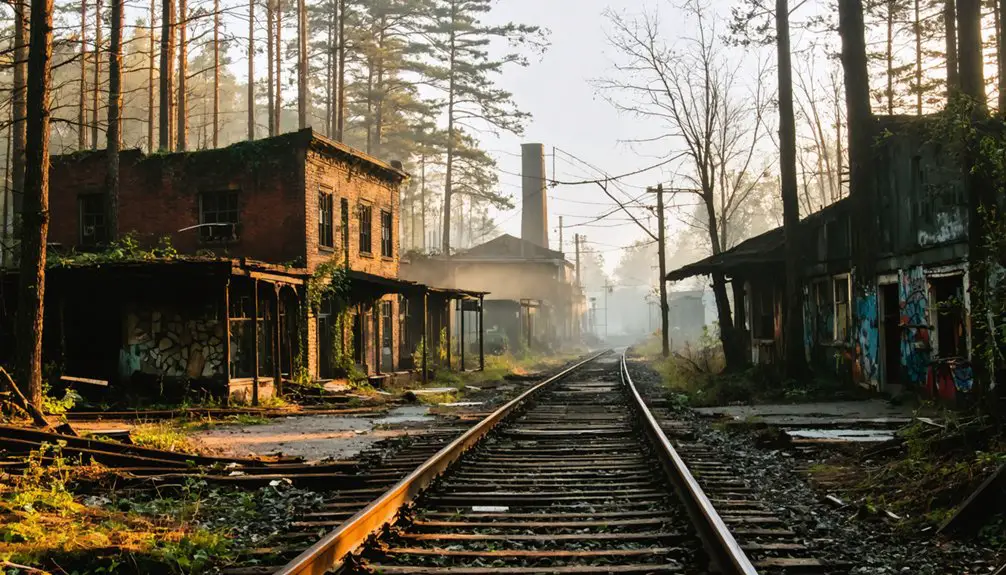You’ll find Feltville Historic District nestled in New Jersey’s Watchung Reservation, where Peter Willcocks first settled in 1720. David Felt transformed it into a thriving industrial village in 1845, building a stationery factory and worker housing for 200 residents. After manufacturing declined, it became Glenside Park summer resort until 1916. Today, you can explore eight preserved historic buildings, including the original church and restored cottages. The site’s rich history holds more than meets the eye.
Key Takeaways
- Feltville Historic District, located in New Jersey’s Watchung Mountains, was originally established in 1845 as a thriving industrial village by David Felt.
- The village peaked with 200 residents during 1850-1860, centered around a stationery manufacturing business powered by a waterwheel.
- After its industrial decline, Feltville transformed into Glenside Park summer resort in 1882 before closing in 1916.
- Eight original houses, a church, and a carriage house from the mid-19th century remain standing today within the 2,000-acre Watchung Reservation.
- Local legends include ghost stories about three missing sisters from 1912 and mysterious supernatural occurrences along Johnston Drive.
The Early Days: Peter Willcocks and the First Settlement
When Peter Willcocks arrived from Long Island around 1720, he became the first known colonial settler of what would later become Feltville.
You’ll find his pioneering spirit reflected in the strategic placement of his settlement near Blue Brook in the Watchung Mountains, close to the village of Turkey (now New Providence).
During the Revolutionary War, one of his children suffered injuries while defending the property.
The Willcocks family established their roots here, with Peter and his wife Phebe raising five children while developing the land’s potential.
In 1736, he constructed a sawmill along Blue Brook, clearing hundreds of acres of forest to support his growing enterprise.
David Felt’s Vision: Birth of a Company Town
The Willcocks family’s influence on the region lasted over a century until David Felt purchased 660-760 acres of their land in 1845, marking the beginning of an ambitious industrial venture.
David Felt’s vision transformed the wilderness into a thriving company town, combining manufacturing with agricultural sustainability.
Felt’s pioneering spirit created more than a factory – he built a self-sustaining community where industry and agriculture coexisted harmoniously.
- You’d find his stationery manufacturing business nestled alongside a brook, with worker housing strategically built on a bluff above.
- You’d experience his commitment to community unity through the town’s carefully planned infrastructure – a general store, post office, and church where residents gathered for weekly services.
- You’d witness a unique blend of industrial and agricultural life, as workers tended to 600 acres of farmland while maintaining their factory duties.
Felt’s Unitarian beliefs shaped the community’s progressive character, allowing residents religious freedom without enforcing specific doctrines.
Just as local history enthusiasts now explore these grounds, the town flourished under Felt’s progressive leadership, reaching a peak population of nearly 200 residents between 1850-1860.
The town flourished under Felt’s progressive leadership, reaching a peak population of nearly 200 residents between 1850-1860.
Life in Feltville During Its Industrial Peak
During Feltville’s industrial peak in the 1850s, you’d find nearly 175 residents bustling through a vibrant company town nestled along Blue Brook.
The community dynamics centered around the printing factory, where workers operated presses and bookbinding machines powered by the brook’s twelve-horsepower waterwheel. The factory specialized in producing business stationery for sale. David Felt ran the town as a benevolent overseer, providing housing and steady work for his employees. You’d see families living in double houses perched on a bluff, enjoying fresh air and open spaces – a stark contrast to crowded city life.
For work-life balance, residents could walk to the general store for supplies, attend services at the local church, and send their children to the village school.
While men worked the factory floor, women managed households, with their daily routines documented in letters and diaries that captured the tight-knit social fabric of this industrial village.
The Decline of Manufacturing and Village Abandonment
Following Feltville’s initial success, harsh economic realities struck the village in the 1850s and 1860s, forcing David Felt to confront mounting financial pressures.
Economic decline, coupled with political troubles and ties to Southern businesses, led him to sell the village after just 15 years of operation. Self-sustaining industrial communities like Feltville struggled to remain viable as larger manufacturing centers emerged.
Under new ownership, the village transformed into Glenside Park resort, but this venture also proved unsustainable.
The manufacturing shifts that followed proved devastating to Feltville’s survival:
- The original 12-horsepower waterwheel became obsolete as industrial technology advanced.
- Transportation changes and emerging industrial centers diminished the village’s competitive edge.
- The Pure Food and Drug Act of 1906 devastated attempts at patent medicine production.
Community disintegration accelerated as families departed, seeking opportunities elsewhere.
Glenside Park: A Summer Resort Transformation
After Feltville’s industrial decline, Warren Ackerman purchased the abandoned village at public auction in 1882 for $11,450, transforming it into Glenside Park, an Adirondack-style summer resort.
During this transformation, local residents expressed mixed reactions and concerns about the development’s impact on water rights and the formerly deserted location.
You’ll find the original worker cottages weren’t demolished but instead renovated to match the resort architecture of the era, emphasizing natural materials and simple aesthetics. Ackerman added just one new structure – the Maskers’ Barn carriage house.
The resort catered to urban middle-class visitors seeking summer leisure in a mountain setting. You can still see how the dining facilities were expanded from existing buildings to accommodate resort guests. The resort attracted visitors until its closure in Glenside Park in 1916.
Surviving Structures and Archaeological Significance
Today at Feltville Historic District, you’ll find eight original worker houses, Masker’s Barn, and the Church/Store building standing as evidence to the 1840s industrial village.
While the mill was demolished in 1930, archaeological excavations have revealed privies, wells, and artifact scatters that provide significant insights into 19th-century worker life.
Recent preservation efforts, backed by $6.5 million in funding, have stabilized key structures and protected important archaeological sites, though many features like the original mill raceway still await thorough investigation.
Original Building Inventory
Within the Feltville Historic District, eight historic houses from the 18th and 19th centuries stand as evidence to the village’s industrial past.
You’ll find historic cottages in varying states of preservation, from fully intact structures to remaining foundations, showcasing typical mill architecture of the era.
- The Church/General Store building serves as a centerpiece, featuring a unique dual-purpose design with retail space below and non-denominational worship area above.
- Hemlock Row houses form a distinct cluster where mill workers once lived, complete with garden plots for growing their own food.
- The Littell-Lord Farmstead remains intact, connecting the village’s industrial heritage to its agricultural roots.
These structures, along with the surviving mill race, pump house, and Masker’s barn, paint a vivid picture of village life.
Archaeological Sites Today
Modern archaeological investigations have revealed extensive structural remains and artifact assemblages throughout the Feltville Historic District.
You’ll find eight original houses, a church, and a carriage house still standing from the mid-19th century, while archaeological digs have uncovered the foundations of David Felt’s residence and other key structures.
The site’s archaeological significance lies in its well-preserved artifacts, which tell two distinct stories: the industrial village era and the later Glenside resort period.
Excavations have unearthed domestic items, tools, and building materials that showcase daily life and social hierarchies.
You can trace the original village layout through surviving gravel walkways, and discover how the spatial organization separated management zones from worker housing areas, contributing to our understanding of 19th-century company towns.
Preservation Restoration Challenges
Preserving Feltville’s historic structures has required substantial financial investment and expertise, with over $6.5 million dedicated to infrastructure improvements and building stabilization.
The historic district’s funding allocation challenges affect the pace of restoration work, while maintaining structural integrity remains a constant priority.
Key preservation challenges include:
- Balancing historic accuracy with modern building codes while installing utilities and ADA-compliant features
- Coordinating preservation efforts across ten surviving structures, including the restored Church/Store and Masker’s Barn
- Managing environmental impacts from the surrounding Watchung Reservation while protecting archaeological resources dating to the 18th century
You’ll find that New Jersey preservation grants totaling $1.1 million have helped stabilize buildings, but continuous support is needed to complete restoration of partially stabilized houses like #4 and #7.
Watchung Reservation’s Hidden Treasure
Nestled within the Watchung Reservation‘s 2,000-plus acres, you’ll find Feltville’s historic structures surrounded by the same dense forest that first attracted settlers in the 1700s.
The site’s natural setting along Blue Brook remains largely unchanged since Peter Willcocks established his sawmill in 1736, though the water features have evolved from industrial use to recreational spots like Lake Surprise.
As you explore the grounds today, you’re walking through layers of local heritage spanning three centuries – from early colonial settlement to industrial village to summer resort, all preserved within Union County’s first park system.
Natural Forest Setting
Deep within the Watchung Reservation lies the Feltville Historic District, surrounded by sprawling northeastern temperate forests of oaks, maples, and hickories.
You’ll discover incredible forest biodiversity as you explore Cataract Hollow’s ravines and ridges, where Blue Brook winds through the landscape. The area’s ecological preservation efforts guarantee native wildlife thrives alongside historical structures.
As you venture through this natural sanctuary, you’ll find:
- Miles of hiking trails showcasing geological formations and seasonal changes
- Native undergrowth filled with ferns and wildflowers supporting local ecosystems
- Peaceful woodland views across the reservation, despite nearby suburban development
The forest setting transforms throughout the year, offering unique experiences from spring blooms to winter’s stark beauty, creating your own adventure in this preserved wilderness.
Rich Local Heritage
The echoes of three centuries of history resonate through Feltville’s remaining structures and stone foundations.
You’ll discover a rich tapestry of cultural influences, from Peter Willcocks’ pioneering sawmill in 1736 to David Felt’s thriving mill town that housed 175 residents by 1850.
The village transformed again when Warren Ackerman reimagined it as Glenside Park, a mountain resort getaway.
During the Depression, the site fostered a close-knit community of county workers who hosted their own community events and published newsletters.
The CCC’s conservation work in the 1930s helped preserve this heritage.
Today, you can explore the restored Church/Store museum and Masker’s Barn, while stone foundations from the Drake Farmhouse tell stories of the agricultural life that sustained generations of residents.
Ghost Stories and Local Legends
Among Feltville’s most chilling tales, a haunting 1912 incident sparked an exodus that forever changed the village’s character. When three sisters vanished in the woods, leaving only their bonnets behind, nearly half the residents fled, and those who stayed prohibited children from entering the forest alone.
The area’s ghostly encounters center around three distinct elements:
- The house at the end of the path, where the sisters’ spirits allegedly remain
- Johnston Drive’s mysterious “witch bumps” that reappear despite repaving
- The Enchanted Forest, where witch folklore claims 13 dark practitioners once held rituals
You’ll find these stories woven into the fabric of Feltville’s identity, from the young girl’s apparition that wanders between homes to the persistent tales of supernatural occurrences in the surrounding woods.
Preserving New Jersey’s Industrial Heritage
Since gaining recognition as a historic industrial site, Feltville’s preservation efforts have aligned with New Jersey’s extensive framework for protecting manufacturing heritage.
You’ll find that the Multiple Property Documentation Form (MPDF) has streamlined the site’s listing process on both state and national registers, opening doors to vital federal tax credits for industrial preservation projects.
Local preservation ordinances now provide the strongest protection for Feltville’s historic character, with oversight from appointed preservation commissions that guarantee appropriate exterior modifications.
Through Morris County’s Historic Preservation Trust Fund, which has distributed nearly $46 million since 2003, you’re seeing increased support for adaptive reuse initiatives.
These preservation efforts don’t just protect buildings – they’re creating opportunities for you to experience New Jersey’s industrial heritage while making sure these landmarks remain viable for future generations.
Frequently Asked Questions
What Modern Amenities Are Available for Visitors to the Deserted Village Today?
Living large, you’ll find wheelchair-accessible buildings, modern facilities with restrooms, self-guided QR tours, parking, visitor services at Church/Store museum, plus Masker’s Barn for events, all with full utilities.
How Long Does It Take to Walk Through the Entire Historic District?
You’ll need 1-2 hours to explore the entire district, depending on your walking pace and how deeply you want to appreciate each building’s historical significance along Cataract Hollow Road.
Are Guided Tours Available, and How Can Visitors Arrange Them?
You’ll find guided tour options mainly during special events like “Four Centuries in a Weekend.” For custom visits, contact the Union County Park System or Visitor Center to arrange group tours.
What Is the Best Time of Year to Photograph the Historic Buildings?
You’ll capture the best photos during fall when autumn foliage peaks and golden hour stretches longer, creating warm light that enhances textures and minimizes harsh shadows on historic architecture.
Can Visitors Conduct Paranormal Investigations or Overnight Stays at the Site?
You can’t conduct paranormal experiences or utilize overnight options at the site, as these activities aren’t permitted. You’ll need to limit your visits to authorized daytime hours and follow preservation guidelines.
References
- https://ucnj.org/wp-content/uploads/2018/05/Interpretive-Signage-at-the-Deserted-Village-of-Feltville.pdf
- https://feltvillefeatures.com/historic-overview-of-feltville/
- https://ucnj.org/parks-recreation/deserted-village/
- https://newjerseymemories.com/deserted-village-of-feltville-new-jersey/
- https://en.wikipedia.org/wiki/Feltville_Historic_District
- https://ucnj.org/wp-content/uploads/2014/06/A-Deserted-Village-in-Union-County.pdf
- https://bestofnj.com/features/jersey-through-history-deserted-village-feltville/
- https://theopenroadahead.com/2020/07/13/deserted/
- https://feltvillefeatures.com/about/
- https://ucnj.org/parks-recreation/deserted-village/self-guided-walking-tour/



